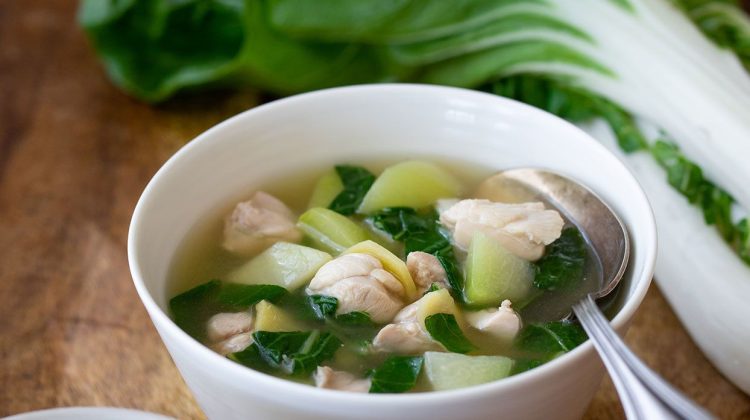
1.Tinola (Filipino Ginger-Garlic Chicken Soup)
What Is Tinola?
Tinola is a Filipino chicken soup flavored with ginger, garlic or onion and fish sauce and traditionally includes green papaya. Some variations swap out the chicken for fish. It is commonly served with rice. Learn more about this healthy Filipino soup here.
What Substitutions Can I Make?
This recipe calls for malunggay leaves or moringa. Moringa comes from the malunggay tree, which grows in the tropics and a few other subtropical environments. The leaves have a mild, slightly bitter flavor. Look for them fresh or frozen at Asian markets. If you can’t find them, you can substitute bok choy leaves (but leave out the stems).
Green papaya is another traditional ingredient in tinola. Green papaya is papaya that has yet to ripen. Its flesh is pale with a firm texture. It’s less sweet compared to ripened papaya and is also available at Asian markets. If you can’t find green papaya, you can use chayote in its place, as it has a similar flavor and texture.
Ingredients
3 tablespoons canola oil or avocado oil
½ cup chopped yellow onion
¼ cup thinly sliced fresh ginger
6 cloves garlic, minced
1 pound boneless, skinless chicken thighs, trimmed and cut into 1/2-inch pieces
4 cups low-sodium chicken broth
1 ½ cups peeled and cubed green papaya or chayote
2 cups chopped malunggay leaves or bok choy leaves
1 tablespoon fish sauce
¼ teaspoon salt
¼ teaspoon ground black pepper
Directions
Heat oil in a large pot over medium heat. Add onion, ginger and garlic; cook, stirring, until the onion starts to turn translucent, about 3 minutes. Add chicken and broth; cook, stirring, until the chicken is just cooked through, about 5 minutes. Add papaya (or chayote), malunggay (or bok choy), fish sauce, salt and pepper; continue simmering until the vegetables are tender and the flavors have melded, about 5 minutes more.
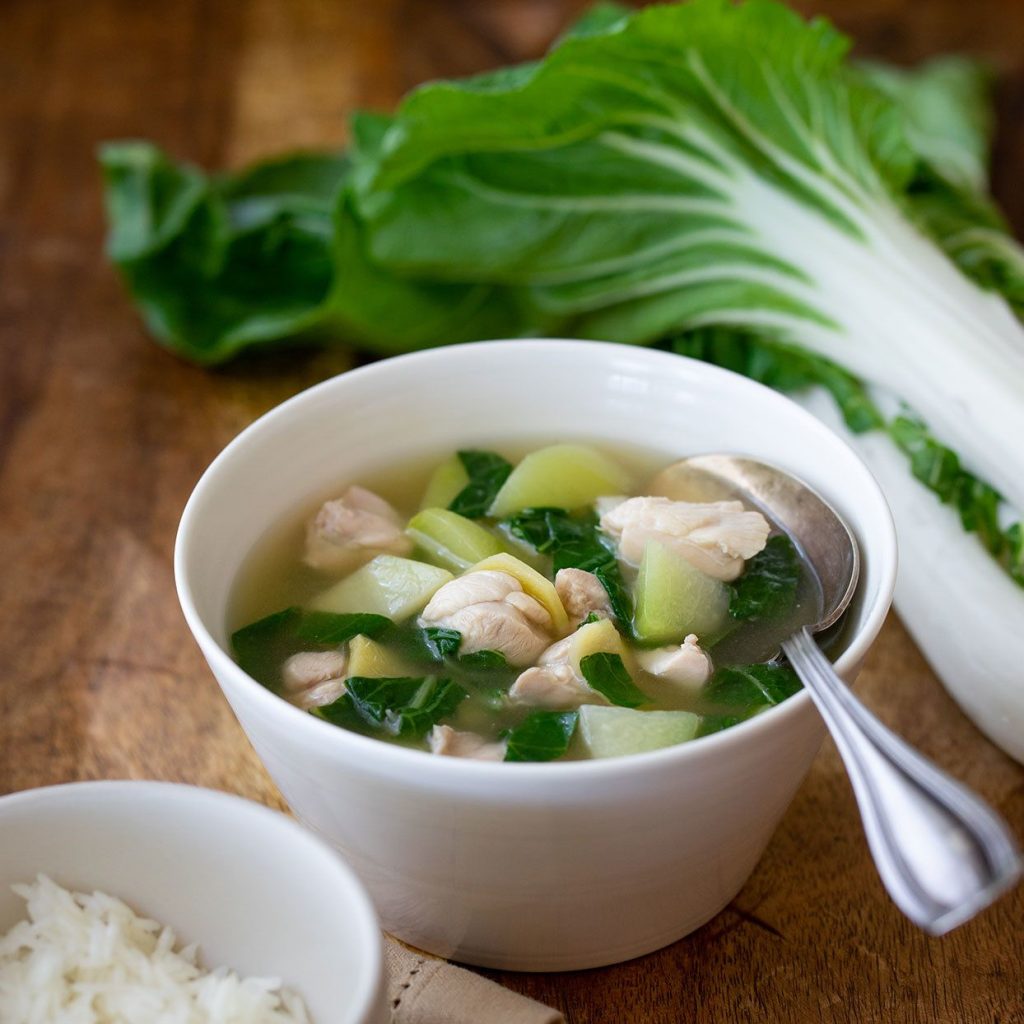
2.Arroz Caldo and Lugaw
You might be familiar with lugaw and goto. These types of congee closely resembles each other. The distinguishing ingredient of arroz caldo is the use of chicken.
Lugaw can be as plain as it can get. It can be cooked using only three ingredients. The simplest lugaw is composed of rice, water, and salt. My grandma always makes this for me when I am not feeling well. She adds an ingredient called rousong to make it taste better.
Arroz Caldo
Goto is another type of congee. This is usually composed of beef tripe. Beef and pork innards are sometimes added into it. Checkout this goto recipe for more details.
Cooking Tips
To make your arroz caldo look and taste better, try topping it with some safflower, toasted garlic, and scallions — squeeze half a lemon and you are done.
Arroz Caldo is usually served during breakfast because it is filling. It can give you the energy that you will need until lunch time.
How to Make Toasted Garlic
Topping some toasted garlic on your arroz caldo is highly recommended before serving. You will need the following: 1/2 cup garlic, minced and 1/2 cup cooking oil.
Pour the oil in a pan then turn on the stove
Put-in the garlic immediately (make sure that the oil is not hot enough to fry the garlic)
Adjust the heat of the stove to “low” and wait until the garlic turns golden brown (or medium brown if desired)
Drain the oil and place in a bowl with paper towel or tissue
Use when needed
Try this Arroz Caldo Recipe. Let me know what you think.
Ingredients
1 ½ lbs chicken cut into serving pieces
1 ½ cups rice uncooked
34 ounces water about 1 liter
2 Tablespoons fish sauce
1 teaspoon garlic
1/4 teaspoon ground black pepper
1 cup onion minced
4 eggs hard boiled
1 cup scallions green onions, minced
2 knobs ginger julienned
3 tbsp safflower kasubha
1 chicken cube bouillon
1 lemon or 4 pieces calamansi
2 Tablespoon cooking oil
Directions
In a pot, heat the cooking oil then saute the garlic, onion, and ginger
Dash-in some ground black pepper
Add the chicken cube and cook until the cube melts
Put-in the chicken and cook until outer layer color turns golden brown
Add the fish sauce and uncooked rice then mix and cook for a few minutes
Pour-in the water and bring to a boil
Stir occasionally and simmer until the rice is fully cooked (about 30 to 40 minutes)
Put-in the hard boiled eggs
Add the safflower for additional color and aroma
Serve hot with garlic, minced scallions, and lemon. Share and Enjoy!
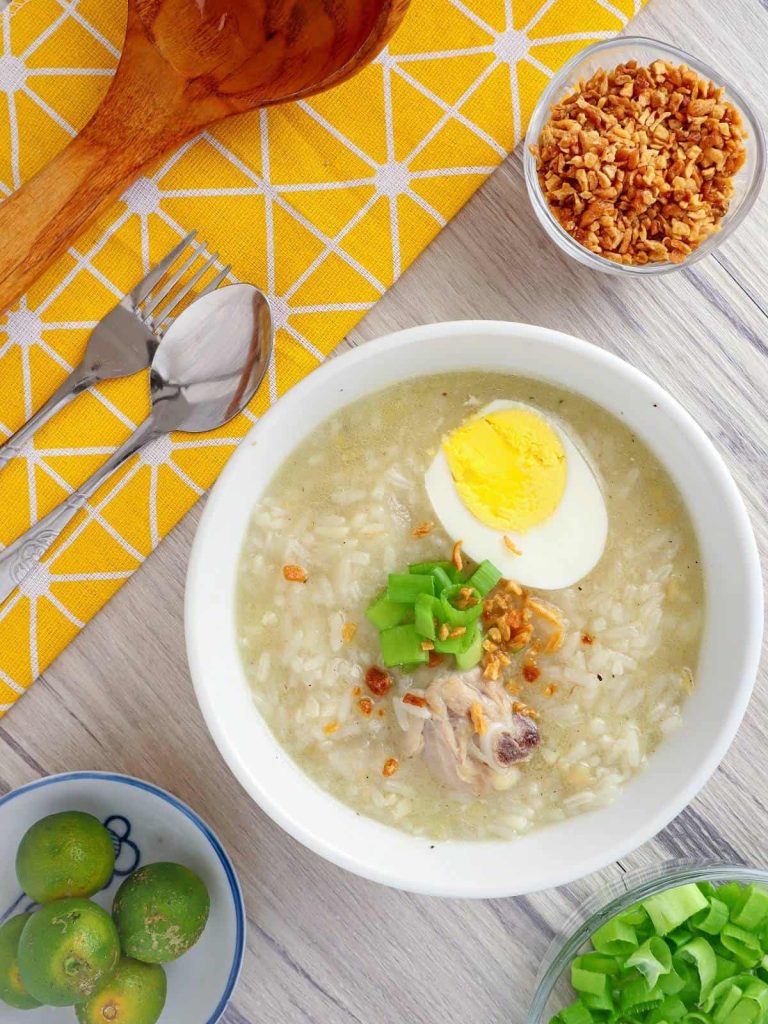
3.Pancit Molo
Pancit Molo is said to have originated from the town of Molo in the province of Iloilo and was influenced by the wonton soups brought in by the large community of Chinese settlers in the area.
The soup comprises meat-filled dumplings, shredded chicken, and a rich, savory broth. Pancit is the Filipino term for noodles, and the noodles in this case are the wonton wrappers.
Ingredients
For the Homemade Broth
1 tablespoon canola oil
1 onion, peeled and chopped
4 cloves garlic, peeled and minced
3 pounds bone-in chicken parts (wings, thighs, breast)
12 cups boiling water
1 teaspoon pepper corns
2 bay leaves
1 tablespoon salt
For the Wontons
1 pound ground pork
1/2 cup green onions, finely chopped
1/2 cup water chestnuts, finely chopped
1 small carrot, peeled and shredded
3 cloves garlic, peeled and minced
1 teaspoon soy sauce
1 teaspoon salt
1/2 teaspoon pepper
30 pieces Molo or wonton wrappers
For Assembly
1 tablespoon canola oil
1 onion, peeled and sliced thinly
2 cloves garlic, peeled and minced
1 tablespoon fish sauce
10 cups homemade broth
salt and pepper to taste
green onions, chopped
fried garlic bits
Directions
Add chicken and cook, occasionally stirring, for about 5 to 7 minutes or until color changes. Lower heat, cover, and cook for about 15 to 20 minutes or until the chicken releases its juices.
Raise heat to high and add boiling water.
Add bay leaves, peppercorns, and salt.
Bring to a boil. Skim scum that accumulates on top.
Lower heat and return to simmer for another 10 to 15 minutes or until chicken is cooked through.
With a slotted spoon, remove chicken pieces. Allow to cool to touch and remove meat from bones. Shred the meat and set aside. Break bones to expose marrow and return to pot.
Continue to cook at barely a simmer, uncovered, for about 1 to 1 1/2 hours or until liquid is reduced and concentrated. ASI
Using a cheesecloth, strain stock to remove bones and aromatics.
For the Wontons
In a bowl, combine ground pork, green onions, water chestnuts, carrots, garlic, soy sauce, salt and pepper. Gently stir until well-distributed.
Arrange the wrapper on a flat surface diagonally and place about a teaspoon of the filling in the center.
Fold the lower half of the wrapper over the filling. Press the sides to remove air bubbles.
Roll up the filled part to completely enclose the filling and press the edges to seal. Bring the two corners together to form a bonnet-shaped dumpling and seal them with a dab of water.
Repeat with the remaining filling and wrapper.
For Assembly
In a deep pot, heat canola oil. Add onions and garlic and cook until softened.
Add fish sauce and cook for about 30 seconds.
Add broth and bring to a boil. Season with salt and pepper to taste.
Stir the broth to create a whirlpool and gently add the wontons in batches. Cook for about 3 to 5 minutes or until they float on the top.
Add chicken and cook for about 2 to 3 minutes or until heated through.
Label soup in serving bowls. Top with green onions and fried garlic bits. Serve hot.

4.TINOLANG ISDA WITH MALUNGGAY (FISH GINGER SOUP WITH MORINGA LEAVES)
Tinolang Isda, commonly known in the Philippines, is a standard method of preparing fish because of how quickly and easily it can be cooked.
The star of this dish is fish, cooked in a broth made from tomatoes, ginger, onions, scallions, and a few other aromatics before being spiced up with some lemongrass and chile.
Add moringa leaves to the mix for an added dose of goodness.
But you can use other green leafy vegetables like spinach, pechay (snow cabbage), water spinach, or even green cabbage as a replacement.
Ingredients
2 lbs Matambaka or big-eye scad fish sliced in desired size
2 medium size Tomatoes ripe and sliced in wedges
1 medium size Ginger peeled and sliced
2 small size Onions peeled and sliced
2 stalks Scallions cut in 2 inches
1 cup Malunggay leaves cleaned and stalks removed
3 pcs Chili pepper
4 cups Water
1 teaspoon Salt
1 stalk Lemongrass
Directions
Step1. Put 4 cups of water in a soup pot. Let it boil.
Step 2. Add the tomatoes, ginger, onions. Cover and let it cook for around 3 minutes.
Step 3. Add the fish followed by the malunggay leaves and lemongrass. Soak the leaves in the water. Let it reboil in a slow to medium heat.
Step 4. Add the scallions, chili pepper and salt to taste. Mix and stir and boil for 2 minutes
Step 5. Transfer to a serving soup bowl and serve it while warm. It is best complimented with rice.
Step 6. Enjoy and happy eating!

5.SOPAS (CHICKEN NOODLE SOUP)
This is a classic Filipino soup that has been enjoyed for generations.
It’s got all the qualities you might want in a bowl of soup: it’s hot, filling, wholesome, and creamy.
Vegetables are commonly used, including carrots, bell peppers, celery, and cabbage.
The broth is typically flavored with chicken.
Noodle options include shell or small tube pasta like ziti, although elbow macaroni is the most common.
INGREDIENTS
1 pound chicken breast or legs
6 cups water
2 cups macaroni – elbow, shell or straight
2 tablespoons butter – or margarine
1 medium onion – chopped
2 cloves garlic – minced
1 big bell pepper – diced
1 medium carrot – diced
1 stalk celery (optional) – chopped
12 fluid ounces (1 can) evaporated milk
1 cup Vienna sausage – sliced
2 cups cabbage – chopped
salt or more
pepper
Directions
Step 1. Boil chicken breast in water with a little salt and pepper. Once cooked, remove from the stock and shred meat into smaller pieces using two forks.
Step 2. In a pot, sauté garlic and onion in butter until tender. Add the chicken meat and noodles and cook for 5 minutes stirring from time to time to avoid burning the noodles.
Step 3. Add the chicken stock to the pot and cover. Once it starts to boil add carrots, bell pepper, and celery and cover again.
Step 4.Once the noodle is cooked al dente, add the milk and sausages. Add more salt and pepper if needed. Let it simmer for a few more minutes until the noodles are completely cooked and soup starts to thicken. Add water or milk if soup becomes too thick.
Step 5. Add cabbage before turning off the stove and cover. Let the cabbage cook for at least 5 minutes from the residual heat. Transfer to serving bowls.
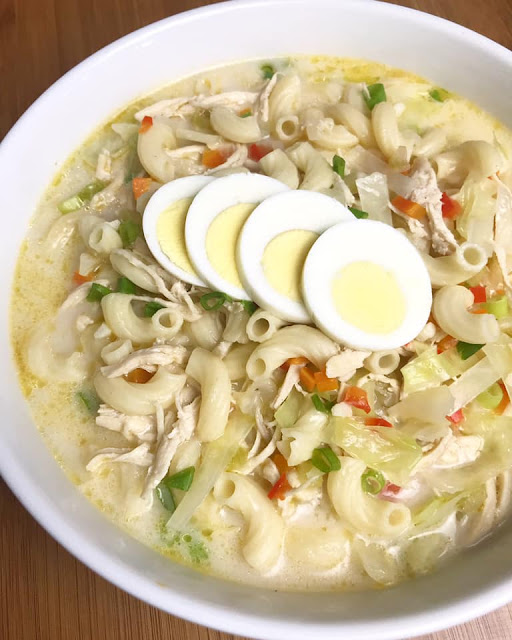
6.Chicken Sotanghon Soup
Chicken sotanghon soup features mung bean thread noodles, shredded chicken, shiitake mushrooms, and a savory rich blend of ginger, garlic, and onions.
Ingredients
6 oz bean thread noodles (Chinese vermicelli noodles, sotanghon noodles)*
1 ½ Tablespoon grape seed oil , or other neutral flavored cooking oil
4 garlic cloves , minced
1 Tablespoon minced fresh ginger
1 medium onion , chopped (about 1 ½ cups)
1 pound skinless chicken breast cutlets, or about 2 cups shredded cooked chicken
1 ½ cup shiitake mushrooms , thinly sliced
10 cups homemade chicken stock *
1 teaspoon kosher salt
freshly ground black pepper , to season
chopped green onions , as needed to garnish
Directions
Step 1.Submerge dried bean thread noodles in warm water. Let soak for 10-15 minutes until softened.
Step 2.Heat oil in a stock pot or large pot over medium-high heat. Once warm, add garlic and ginger. Stir often and cook until fragrant, about 30-45 seconds. Add onions and stir to combine.
Step 3. Once onions are almost translucent, about 2 minutes, add raw chicken. (Skip if using cooked chicken.) Cook until chicken registers at least 165 degrees F. Turn chicken as needed to cook evenly, about 5 minutes.
Step 4. Add mushrooms and cook for 2 minutes. Stir as needed to ensure onions do not burn at the bottom of the pot.
Step 5. Add chicken broth. Remove cooked chicken and place on plate or cutting board to cool. Bring broth to a boil. Let boil for about 2 minutes. Reduce heat to a simmer.
Step 6. Shred cooled chicken using two forks. Add shredded chicken to stock pot. Season broth with salt. Taste. Add more salt, as needed.
Step 7. Drain soaked noodles. Add to pot. Stir to distribute. Bring soup back to a boil. Let boil for 2 minutes. Reduce heat to a simmer and cook for another 3-5 minutes.
Step 8.Ladle soup and noodles into serving bowls. Season with black pepper or white pepper according to taste. Garnish with chopped green onions.

7.BULALO (FILIPINO BEEF MARROW STEW)
Beef shanks and marrow bones are the main ingredients in the Filipino dish, the Bulalo.
It’s a light-colored soup famous in the Philippines’ Southern Luzon region and is made rich by slow-boiling beef shanks and beef marrow bones, which take many hours.
The seasonings might range from only salt and black pepper to soy sauce, bay leaves, and even garlic depending on the cook.
But at its heart, Bulalo is just a hearty stew cooked with whatever vegetables a cook happens to have on hand.
beef marrow bones (cut to expose marrow on one end)
1 pound
beef shank
1
onion quartered
3 cloves
garlic
1 teaspoon
black peppercorns
2 tablespoons
patis (fish sauce)
salt (to taste)
2 cobs
corn (cut into 2-inch segments)
1
chayote (peeled and cubed)
3
baby bok choy (leaves separated)
Directions
Step 1. Boil a large pot of water. Add the marrow bones and beef shank and return to a boil. Continue boiling until you don’t see any more red blood coming from the meat or bones (about 10 minutes), then remove the meat and bones with tongs and scrub under cold water to remove any scum. Dump the water in the pot out and rinse the pot. This process rids the meat of excess blood and will ensure your soup is nice and clear.
Step 2. Return the cleaned meat and bones to the pot then add the onion, garlic, peppercorns and patis. Cover with water then bring it to a rolling boil and skim off any scum that accumulates.
Step 3. Reduce the heat to medium low. If you are using a pressure cooker, afix the lid and let it cook for 1 1/2 hours. If you’re not using a pressure cooker, simmer until the meat on the shank is fork tender (4-5 hours). Skim off any excessive fat from the top but do not remove it all (remember, fat=flavour). Transfer the meat and bones to a bowl, then strain the stock through a fine mesh sieve, discard the solids then return the meat and bones to the strained stock.
Step 4. Add the corn and chayote and simmer for another 20 minutes or until the chayote is tender. Salt to taste, then add the bok choy at the last minute. Serve with rice.

8. Salmon Sinigang
Filipino Sour Soup with salmon is a must-try quick to prepare,po,
WHAT IS SINIGANG?
Sinigang is a traditional soup from the Philippines and means “stew”. It features abundant veggies, including lots of greens, some type of meat, or fish, married together in an incredibly savory, tangy broth. The ingredients of this soup vary as each region in the Philippines has its own spin on it.
Tamarind is the surprising ingredient that adds so much bright full flavor!
ingredients in sinigang
Miso and Fish sauce (or vegan fish sauce) round out the sour tang of the tamarind puree and create a delicious balance.
INGREDIENTS IN SINIGANG
Salmon -or substitute with crispy seared tofu. (or sub pork, chicken or beef)
red onion
garlic
ginger
tamarind puree or paste
fish sauce (or try this vegan fish sauce)
vegetable stock
eggplant (optional): or sub other veggies like string beans, okra, tarot root, or long beans
greens: baby bok choy, napa cabbage, spinach, water spinach, Mizuna, mustard greens, or collards
fresh tomatoes
white miso paste
Directions
Step one.
This step is totally optional but it gives a richer flavor to the salmon. Sear the salmon on each side for about 2- 3 minutes (depending on the thickness of the fillets) in a very hot pan with oil. Leave it alone until a crust forms. Just go for getting a crust on the outside. The interior will finish cooking in the broth.
Step 2. Prep the onions, ginger and garlic.
Step 3: Saute onion, garlic, and ginger for 2 minutes.
Step 4: Add broth, tamarind, fish sauce, eggplant and serrano chili to the pot. Bring to a low gentle boil for 10 minutes, or until eggplant is tender.
Step 5: Add salmon, tomatoes and Bok Choy (if using spinach or other tender green) wait and add just before serving), cook another 5 minutes or until salmon is just cooked through. Add miso water mixture.
Step 6: Garnish with fresh cilantro and daikon radishes. Serve with rice if desired.

9.Egg Drop Soup
On chilly days, you can’t go wrong with this broth that’s as light as it is delish.
This is a tasty and surprisingly simple soup dish.
It just takes a few essential ingredients to make, but it also tastes great.
Use this recipe the next time you’re in a hurry yet still want a delicious meal for dinner.
Eat your favorite toasted sandwich alongside your egg drop soup.
INGREDIENTS
8 cups chicken broth I used Better than Bouillon chicken base
¼ cup cornstarch
¼ cup water to dilute cornstarch
2 teaspoons sesame oil
3 eggs beaten
¼ cup green onions chopped
Salt and ground black pepper seasoning
Directions
Step 1. Bring the chicken broth to a boil using a large pot. Mix cornstarch with water and slowly add to the boiling broth. Lower the heat then simmer for 2 minutes to cook the cornstarch.
Step 2. Add sesame oil. Taste and add salt and ground black pepper according to your taste.
Step 3. Slowly add the beaten eggs while stirring the soup to create egg “ribbons”.
Step 4. Turn the heat off and add chopped green onions. Serve hot.

10. Beef Lauya
Beef Lauya is explicitly geared toward Filipino palates as a dish created and perfected in the Philippines.
This classic soup shares a similar preparation process with meat Nilaga.
The main distinction is the inclusion of aromatics like ginger and garlic.
The combination of beef shank, sweet potatoes, sugar, garlic, and ginger in a steaming dish is irresistible.
Soup with a reputation for being delightful and comforting, as many do.
Ginger’s subtle heat will make you feel toasty inside and out.
Ingredients
3 lbs beef shank (bone-in), cut into serving pieces
4 cloves garlic, crushed and peeled
1 large onion, peeled and halved
Small knob fresh ginger, peeled and crushed
1tsp whole peppercorns
1 large potatoes, peeled and cubed
3 (around 1 lb) sweet potatoes, peeled and cubed
3 ripe saba bananas (plantain), peeled and sliced diagonally
1 small green cabbage, halved and cored
1 small Napa cabbage, bottom cut
2 Serrano peppers
Fish sauce or salt to taste
Brown sugar to taste, optiona
Directions
Step 1. Put beef in a big pot and add enough water to cover it. Add salt and bring to a boil over high heat. Skim off scum accumulated on the surface, reduce heat to medium, cover and simmer for two hours, or until meat is fork tender. Add more water as needed.
Step 2. Increase heat to medium high and then add garlic, onion, ginger, peppercorns and potatoes; cook for 10 minutes.
Step 3. Add saba, cabbages and Serrano peppers; cook for another 10 minutes or until potatoes are fork tender.
Step 4. Correct seasoning by adding fish sauce or salt and brown sugar, if using. Serve with steamed rice and fish sauce with lemon juice on the side.
Step 5. Enjoy!

11. Pork Pata Pochero
Similar to nilaga, but with the addition of tomato sauce and garbanzo beans, is Pork Pata Pochero.
Make it for a little get-together or a weekend snack when you just want to relax.
This soup, at its finest, is loaded with comforting and nostalgic tastes that will instantly transport you back to your childhood.
Bananas add a pleasant sweetness, garbanzo beans add a nutty, earthy flavor, and fatty pig legs make for a hearty, comforting supper.
Directions
1.5 lb pig’s leg (pata) chopped
3 medium tomatoes, diced
1 medium onion, diced
2 teaspoon garlic, minced
2 to 2½ tablespoons patis (fish-sauce)
1 tablespoon whole pepper corn
1 small can tomato sauce
1 cup chickpeas (garbanzos)
2 plantain banana (ripe), chopped
1 medium sized potato, cubed
1 carrots, peeled & sliced
1 small cabbage, quartered
¼ lb string beans or green beans
1 bunch bok choy (pechay)
1 cup water (adjust to preference if you want it soup style)
2 tablespoons cooking oil
SeaNGREDIENTS:
1.5 lb pig’s leg (pata) chopped
3 medium tomatoes, diced
1 medium onion, diced
2 teaspoon garlic, minced
2 to 2½ tablespoons patis (fish-sauce)
1 tablespoon whole pepper corn
1 small can tomato sauce
1 cup chickpeas (garbanzos)
2 plantain banana (ripe), chopped
1 medium sized potato, cubed
1 carrots, peeled & sliced
1 small cabbage, quartered
¼ lb string beans or green beans
1 bunch bok choy (pechay)
1 cup water (adjust to preference if you want it soup style)
2 tablespoons cooking oil
Directions
Step 1. In a pan, pour a little cooking oil and sauté garlic, onions, and tomatoes.
Step 2. Put in pork pata slices and cook until the color turns light brown.
Step 3. Season with fish sauce, whole pepper corn, and tomato sauce. Mix well.
Step 4. Pour water and let it boil. Simmer until pork is tender using lowest heat. (about 30 to 40 minutes).
Step 5. Add sliced potatoes, plantains and chickpeas. Cook for additional 5 to 7 minutes.
Step 6. Add cabbage and long green beans. Cook for 5 minutes.
Step 7. Stir-in the bok choy. Cover the pot and turn off the heat.
Step 8. Let the residual heat cook the bok choy (about 5 minutes).
Step 9.Transfer to a serving plate and serve.
Step 10. Share and enjoy!
12. Suam Na Mais (Corn Soup With Shrimps & Spinach)
Who doesn’t enjoy a warm bowl of corn soup on a cold night?
For a delicious way to enjoy fresh corn when it’s in season, try making Suam Na Mais.
Corn kernels, shrimp, spinach leaves, and fish sauce come together in a light broth in this traditional Filipino soup.
This Filipino corn soup is perfect for the whole family during the cold winter.
This dish can be enjoyed whenever the need arises for warmth and comfort.
Ingredients
4 whole ears of corn, husks peeled, silk tendrils removed
1 Tablespoon lemon juice
1/2 pound fresh shrimps shells peeled, tails and heads removed
2 cloves garlic minced
1 whole white or yellow onion chopped
1 Tablespoon finely sliced fresh ginger sliced in thin strips
2 Tablespoons patis (fish sauce)
8 cups organic vegetable broth
3 cups kangkong (water spinach) or use regular baby spinach
1/2 teaspoon salt
1 teaspoon freshly ground black pepper
for serving: boiled rice
Directions
Step 1. Prepare the corn. Peel down the husks and remove the silky tendrils. Place the corn cobs in a large stockpot filled with water. Bring the water to a boil over medium high heat. Lower the heat to a medium and simmer for 10 minutes to cook the corn. Turn off heat. Cover the stockpot and set aside.
Step 2. Prepare the shrimps. Wash and remove shells, tails and heads. Sprinkle lemon juice on shrimps and set aside.
Step 3.Remove the cooked corn from the stockpot. Place corn cobs on a colander for a few minutes to drain excess liquids. Using a sharp knife, strip the corn kernels off the cob. Set aside.
Step 4. Using the same large stockpot over medium high heat, add the cooking oil. Saute the garlic, onions and ginger for about 2 minutes till onions are translucent.
Step 5. Add the peeled shrimps and fish sauce (“patis ). Pour the vegetable broth or rice wash.
Step 6. Add the corn kernels. Bring liquid to a boil, then lower to a slow simmer. Continue till shrimps turn a pink-orange hue and the corn kernels are soft. This takes about 8 to 10 minutes.
Step 7. Lastly, add the spinach and cook for 1 to 2 minutes more. Season with salt and pepper.

13.Pancit Lomi Recipe (Lomi Batangas)
Another popular version of the Filipino noodle dish pancit is Pancit Lomi.
While Filipinos typically eat pancit (noodles) at parties, the rich broth in this Pancit Lomi recipe makes it a go-to dish for solace during the wetter months.
Lomi is seasoned with chicken stock, fish sauce, cornstarch, and garlic and is very similar to Pancit Molo.
The critical difference is that Pancit Molo is made using fresh, thick egg noodles, which give it a slimy yet delectable texture.
INGREDIENTS
1 cup pork strips boiled
½ cup pork liver
½ cup kikiam
¼ cup garlic minced
½ cup onion thinly sliced
7 cups pork or chicken stock
1 lb lomi noodle (Since it’s not available here, I used udon noodles)
5 tbsp cornstarch dissolved in 3 tbsp water
2 eggs beaten
3 tbsp fish sauce
2 tbsp vegetable oil
I love creating free content full of tips for my readers, you. I don’t accept paid sponsorships, my opinion is my own, but if you find my recommendations helpful and you end up buying something you like through one of my links, I could earn a commission at no extra cost to you. Learn more
Check out our new cookbook
Bitemybun’s family recipes with complete meal planner and recipe guide.
Try it out for free with Kindle Unlimited:
Pancit lomi is yet another variation of the famous pancit.
However, though we’re used to having pancit as a fiesta fare, this pancit lomi recipe is different in that it’s usually eaten as comfort food during the rainy season because of (surprise!) its broth.
Yes, pancit lomi is that one pancit recipe that has thick broth in it, brought about by the cornstarch mixture in the recipe.
Pancit Lomi Recipe (Lomi Batangas)
The dish is quite popular in mini eateries in the Philippines, where you can get a bowl of it for less than $2. And trust me, each sip is worth every penny!
Among other things, chefs can get really creative in preparing their own version of pancit lomi. On one hand, you can see chicken toppings, pork, meatballs, liver strips, and sometimes, some shrimp. Other chefs would also consider pork chicharon as a topping, just like the monggo soup dish.
Pancit Lomi Batangas
Pancit lomi uses egg noodles, and the difference in the ingredients of the noodle itself is what gives cooked pancit lomi a different flavor and texture, which is on the slimy but yummy side.
The presence of the broth also sets it apart from other pancit recipes.
In its very basic version, pancit lomi includes only chicken strips or pork liver strips, Chinese cabbage, eggs, and carrots. But if you want to add more to the dish, you’re welcome to do so.
INGREDIENTS
1 cup pork strips boiled
½ cup pork liver
½ cup kikiam
¼ cup garlic minced
½ cup onion thinly sliced
7 cups pork or chicken stock
1 lb lomi noodle (Since it’s not available here, I used udon noodles)
5 tbsp cornstarch dissolved in 3 tbsp water
2 eggs beaten
3 tbsp fish sauce
2 tbsp vegetable oil
For the toppings:
½ cup kikiam
15 meatballs
Toasted garlic
Directions
Step 1. In a bowl, mix all ingredients until they’re blended well.
Step 2. Scoop 1 ½ tbsp and shape into a ball. Lay on a greased plate to avoid sticking.
Step 3. Deep fry in vegetable oil over medium-low heat until brown.
Step 4. Remove from oil and drain on paper towels. Set aside.
Step 5. In a large saucepan, stir-fry ½ cup kikiam for toppings in oil for about 3 minutes. Transfer to a plate and set aside.
Step 6. In the same saucepan, stir-fry liver until no more red color is showing. Transfer to a plate and set aside.
Step 7. Sauté pork until brown. Add garlic and sauté until golden brown.
Step 8. Add the other ½ cup kikiam and onion. Sauté until onion is translucent.
Step 9. Add the stock and fish sauce. Bring to a boil. Add noodles and simmer for 3 minutes.
Step 10. Add salt and pepper to suit your taste.
Step 11. Add the cornstarch and stir until the soup thickens.
Step 12. Add the beaten egg and stir until egg threads form. Remove from heat.
Step 13. Serve hot and top with kikiam, meatballs, and toasted garlic.

14. Vegan Mung Bean Soup (Ginisang Munggo)
Vegan Ginisang Munggo, or Mung Bean Soup, is a plant-based alternative to the classic Filipino soup Ginisang Munggo.
Vegan mung bean soup is a low-cal delight that is both simple and filling.
Fish sauce, beef or pork fat, and heaps of pork rinds (or chicharrones) are frequently used in traditional ginisang munggo, making it unsuitable for vegans.
This dish can be enjoyed by vegans by omitting the usual animal ingredients.
Taste-wise, it offers pleasant heat without being too spicy, perfect for the cold winter months!
INGREDIENTS
2 cups dried mung beans
1 small yellow onion minced
1 Roma tomato chopped
2 cups spinach
3 cloves garlic minced
6 cups veggie broth
2 tbsp oil
Salt and pepper to taste
Vegan pork rinds optional
Additional water as needed
Directions
Step 1. Bring 6 cups of veggie broth to a boil in a large pot. Thoroughly wash and rinse the mung beans, then add them to the pot. Boil the mung beans for about 40 minutes until they are very soft and mushy. Check every 10 minutes and add more water as needed.
Step 2. Heat the oil in another large pot on medium heat, then add the garlic, onions, and tomatoes. Saute for 2-3 minutes.
Step 3. Add the cooked mung beans to the pot, including all the contents, and stir to combine. The soup will be very thick, so add more water to reach desired consistency. Cover and let the soup simmer for 10 minutes, stirring occasionally, then throw in the spinach leaves to wilt for the last 1-2 minutes. Season with salt and pepper to taste
Step 4. Top each serving with vegan pork rinds (optional) and serve with white rice.

15. Beef Nilaga Soup
If you want to make the best nilaga, beef is the secret ingredient.
This basic soup gets its flavor from the meat, so if you’re going to splurge on something, make it high-quality beef.
Then, let the water, beef, seasonings, and whatever else you throw into the pot and simmer until the beef is fork-tender.
Lightly season it so that you may serve it with a small plate of patis and a touch of lemon.
This is really one of the simplest beef soups you can cook! What makes it so delicious is really the beef.
How do you cook nilaga?
The key to the best tasting nilaga is the beef. The beef gives this simple soup its flavor so if you’re going to spend on something, buy fresh and flavorful cuts of beef. Then it’s just a matter of letting the water, beef, seasonings, and other ingredients you want to add in simmer until the beef is incredibly tender. Season lightly so you can serve it with a tiny platito of patis and a squeeze of calamansi. It’s comfort food at its most warming
Prep Time
15 mins
Cooking Time
1 hr 30 mins
Ready in
1 hr 45 mins
Yield
4
Cuisine
Filipino
Cooking method
Boil
Beef Nilaga Ingredients
4 cups water
salt
1/2 kilo beef, use beef brisket or beef cubes
2 medium onions, quartered
2 medium potatoes, quartered
1 teaspoon peppercorns
4 tablespoons fish sauce
1 cabbage, quartered
1 bundle pechay leaves
salt, to season
Directions
Step 1. In a big casserole, place beef and pour in water. The water level should be just above the meat.Bring to boil and let it simmer for 10 minutes then remove scum (frothy fat) on top while simmering.
Step 2. Add onions, cover, and simmer for 1 to 1 and 1/2 hours or until beef is tender.
Step 3.Add more water and potatoes, continue to simmer until potatoes are cooked.
Step 4. Add peppercorns and fish sauce.
Step 5. Place the cabbage then the pechay just when you are about to serve. Do not overcook the vegetables. Adjust the taste with salt.

16. Beef Pares Mami
Another traditional Filipino noodle soup is Beef Pares Mami.
Its immense popularity has catapulted it to the status of street food, despite its more traditional presentation as a soup.
Slowly braised meat is cooked until it falls apart in a flavorful liquid.
Then, fresh egg noodles are added to the pot to provide a hearty meal for the whole family.
Ingredients
2 tbsp cooking oil of choice
6 cloves garlic, peeled and crushed
2.2 lbs (1 kg) chuck roast or beef brisket, cut into bite-sized cubes and seasoned with 1 tsp each of salt and pepper
4 cups (1 L) beef broth or beef stock, homemade or storebought
4 cups (1 L) water
2 cinnamon sticks
6 star anise, dried
1 1/2 tbsp (23 ml) soy sauce, or to taste
1 1/2 tbsp (23 g) sugar
salt and pepper, to taste
1 lb (455 g) package cooked egg or mami (chow mein) noodles, blanched briefly in hot water then drained
1 napa or savor cabbage, shredded coleslaw-style
green onions or scallions, sliced thinly
hard-boiled eggs, peeled and halved, for serving
fried garlic, for serving
red chili, sliced, for serving
lime slices, for serving
Directions
Step 1. Heat the oil in a stock pot over medium heat. Add the garlic and cook for 1 minute or until aromatic. Add the beef cubes and cook for 20 minutes, turning the meat halfway through the cooking time, until the beef is browned all over and has released its fat. Add the beef broth and water to the pan, then add the cinnamon sticks and star anise. Bring to a boil then lower the heat to a simmer. Cover and cook until the meat is tender, between 11⁄2 and 2 hours. Season the broth with the soy sauce, sugar and salt and pepper, to taste.
Step 2. Ladle the noodles into individual bowls and top with a portion of the cabbageand green onions. Then ladle the hot soup and beef cubes on top. Garnish withthe fried garlic and red chili (optional). Serve with lime slices on the side.
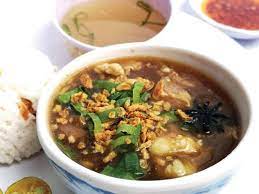
17. Nilagang Baboy (Pork Nilaga)
Pork Nilaga is quite similar to Beef Nilaga, except pork is used instead of beef.
To make Nilagang Baboy, you just toss all the ingredients into a saucepan and cook on low heat until the meat is cooked.
This Filipino meal is made heartier by adding corn and ripe saba (banana plantain) while cooking.
This treat is the way to go if you want to amaze your loved ones and possible guests with a complete, authentic Filipino feast.
Ingredients :
1 lb. pork (choices of belly, hocks, neck or any bony parts of pork), cut into serving pieces
5-6 cups water
1 whole corn
3 cloves garlic, crushed
1 onion, quartered
2 green onions (scallions), sliced into 1” long
1/4 tsp. peppercorn
salt to taste
2 eddoes- also known as taro or gabi, quartered (optional)
2 potatoes, quartered
Banana Plantain (saging na saba)
1 can pork and beans
pechay (bok choy) or cabbage leaves
Directions
Step 1. Place pork in a big pot and let it covered with water. Bring to a boil. Lower the heat and let it simmer until pork is tender for about an hour.
Step 2. Remove all the resulting scum that will rise to the top of the pot.
Step 3. Add crushed garlic, sliced onions, scallions, peppercorn and season with salt.
Step 4. Add quartered eddoes (if using), whole corn, saging na saba and potatoes. Cook until tender.
Step 5. Add the pork and beans. Simmer for 5 minutes. Adjust according seasoning to taste.
Step 6. Add pechay or cabbage leaves. Do not overcook the green vegetables.
Step 7. Remove from heat. Serve hot.
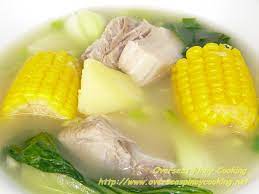
18. Batchoy Tagalog
Filipinos love their soups.
One of the most well-known is Batchoy Tagalog, which is traditionally made with a pig, swine offal, pork blood, and noodles that have been sautéed in onion, garlic, and ginger.
La Paz Batchoy is a popular Filipino dish that has its start in La Paz, Iloilo City.
Many different regional variations of batchoy exist, but this Tagalog version is so easy and requires just seven ingredients (no offal or noodles) that it could quickly become a go-to dish for comfort.
This is excellent with rice and some fish sauce on the side.
Ingredients
1 pound pork tenderloin cut into bite size pieces
1 small onion chopped
6 cloves garlic minced
2 – 3 tablespoons ginger julienned
5 cups water
3 tablespoons fish sauce
1 teaspoon salt
½ cup pepper leaves any pepper leaves
Directions
Step 1. Heat oil over medium heat.
Step 2. Sauté onion for two minutes.
Step 3. Add garlic and cook till golden brown.
Step 4.Toss-in ginger. Cook until aromatic and golden.
Step 5. Add pork tenderloin and cook until light brown.
Step 6. Stir in fish sauce.
Step 7. Add lemongrass if desired. This is optional.
Step 8. Pour water. Bring to boil and simmer until pork is tender.
Step 9. Turn off heat and add pepper leaves. Garnish with chopped green onions.

19. Filipino Pork Stew (Linat-Ang Baboy)
In Cebu, Philippines, Linat-Ang Baboy is a popular meal.
It’s no surprise that Filipinos enjoy this dish so much on gloomy days, as its flavor is wonderfully comforting, rich, and filling.
It’s a straightforward pork-based stew, with pork belly or ribs as the base, garlic, onion, and kabocha squash for taste and texture.
Whether you prefer your stews on top of rice or as a side dish, Linat-Ang Baboy can be served either way.
INGREDIENTS
▢2 lbs pork ribs
▢6 cloves garlic chopped
▢1 medium onion chopped
▢1/2 kabocha cut into large cubes
▢1 chayote cubed
▢2-3 cups kangkong leaves on-choy
▢2-3 cups string beans sitaw
▢salt
Step 1. Rinse meat under running water, add to pot and cover with water. Bring to a boil, dump water and rinse meat again. Cover with water, add about 4 tbsp. salt. Bring to a boil, then reduce to a simmer. Simmer until tender, about 1.5 to 2 hours.
Step 2. You can saute the onion + garlic separately if you want. When the meat is just about done, add onion, garlic, chayote, string beans and kabocha into the pot. Add enough water to cover and salt to taste.
Step 3. In the last 1-2 minutes add kangkong leaves.
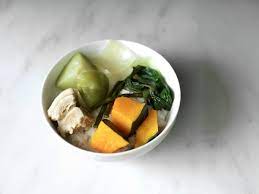
20. Sinigang Na Hipon (Filipino Shrimp Sour Soup)
This Filipino shrimp soup’s sourness and deep savory flavor make it well-known.
Aside from the shrimp, the other main ingredients in this sour soup include string beans, long green chili peppers, radishes, tamarind pods (or sinigang mix), and fish sauce.
A close check on the pot is necessary to prevent overcooking due to the rapid cooking time of all these ingredients.
Ingredients:
2 pounds Shrimps
2 pieces Radishes orLabanos, sliced
1 bunch Water Spinach or Kangkong leaves
5-8 pieces Long String Beans or Sitaw, cut in 2 inches length
3 Long Green Pepper or Siling Pang-sigang, cut in half
2 Knorr Shrimp Broth Cubes
1 pack Sinigang Mix
2 pieces Tomatoes, quartered
1 medium Onion, sliced
1 tablespoon Fish Sauce(Patis)
1 teaspoon Pepper
6 – 8 cups water
Directions
Step 1. Put together in a deep pan onion, tomato, radishes, string beans, shrimp cubes, water and sinigang mix. Bring to a boil.
Step 2. Turn the heat down and simmer until the radishes and the string beans are cooked.
Step 3. Add the shrimp and green pepper and cook for 5 minutes.
Step 4. Turn the heat off and add the water spinach.
Step 5. Serve hot with rice.

21. KBL (Kadyos Baboy Langka)
Kadyos Baboy Langka, or KBL for short, is an iconic Ilonggo dish with deep roots in the culture.
This dish combines pigeon peas (also known as kadyos), pork, and young jackfruit (langka) with batuan and sweet potato leaves.
You will fall in love with the soup at first taste due to its sour, smokey, and highly appetizing flavor.
When making a pork broth, the secret to the softest texture is to pre-boil or grill the pork.
Ingredients
10 cups of water (add more as needed)
1.5 lbs pork cubes (pork belly, pork hocks, pork shoulder)
1.5 cups kadyos (pigeon peas), soaked overnight in water
2 stalks lemongrass, sliced
1 medium onion, quartered
8-10 pieces batuan (or 2 tsp sinigang mix)
3 cups young jackfruit (langka), cut into cubes
1/2 tsp white ground pepper or to taste
salt to taste
2 pieces finger chilies
1 bunch sweet potato leaves
Directions
Step 1. In a big pot, pour-in water and add pork slices. Bring into a boil and add kadyos beans. Simmer for about 20 minutes. Add more water as needed.
Step 2. Add lemongrass and onion. Simmer until meat is tender.
Step 3. Add batuan or tamarind and langka. (make sure to add the souring ingredients when meat is already is tender) Season with ground pepper and salt to taste. Continue to simmer until meat is fully tender and vegetables are cooked.
Step 4. Add finger chilies and sweet potato leaves. Simmer for additional 2 minutes allowing the chilies and leaves to cook. Remove pot from heat and transfer in a serving bowl. Best when serve hot with steamed rice. Enjoy!

22. Binakol Na Manok (Filipino Chicken & Coconut Soup)
The island of Panay in the central Philippines is the inspiration for the exquisite brothy soup known as binakol.
Subtle undertones of sweetness from the coconut and lemongrass are complemented by the lemongrass’ floral overtones, and the faint bitterness from the moringa leaves in this aromatic soup.
Ingredients
Save Recipe
1 1/4 cups (3 1/2 ounces; 100g) shredded unsweetened coconut
1 tablespoon (15ml) canola or other neutral oil
8 chicken drumsticks (about 2 1/2 pounds; 1.1kg), patted dry with paper towels
Kosher salt and freshly ground black pepper
14 medium garlic cloves, minced
1/2 medium white onion (about 3 ounces; 85g), thinly sliced
8 1/2 cups (2L) unsweetened coconut water, such as Harmless Harvest
4 cups (0.9L) homemade or store-bought chicken stock
4 stalks lemongrass (7 ounces; 200g), bottoms smashed under the flat side of a knife
Four 3-inch knobs fresh ginger (70g), quartered
1 scallion, ends trimmed and sliced thinly on a bias for garnish, trimmings reserved
2 chayote squash (about 14 ounces; 400g), peeled, quartered, seeded, and thinly sliced
2 tablespoons (30ml) fish sauce
Kosher salt
8 ounces (225g) fresh spinach, rinsed
Directions
Step 1. Adjust oven rack to top position and preheat to 375°F (190°C). Spread coconut on a rimmed baking sheet. Bake, shaking pan occasionally, until golden brown, about 10 minutes. Transfer toasted coconut to a small bowl; set aside.
Step 2. Line a rimmed baking sheet with paper towels. In a large Dutch oven, heat oil over medium-high heat until shimmering. Season chicken all over with salt and pepper and add to Dutch oven. Cook, turning occasionally, until chicken is well browned on all sides, about 12 minutes. Transfer chicken to prepared baking sheet and set aside.
Step 3. Add garlic and onion to now-empty Dutch oven and cook, stirring occasionally, until garlic is lightly browned and onion is translucent, about 5 minutes.
Step 4. Add coconut water, chicken stock, lemongrass, ginger, and scallion trimmings, along with reserved chicken and 3/4 cup plus 2 tablespoons reserved toasted coconut. Bring to a boil over high heat and cook for 15 minutes, then lower heat to maintain a steady simmer.
Step 5. Add chayote, cover, and cook until chayote and chicken are cooked through and tender, about 20 minutes. Discard lemongrass, ginger, and scallion trimmings. Add fish sauce and season with salt to taste.
Step 6. Add spinach, cover, and cook until soft, 3 to 5 minutes.
Step 7. To serve, divide chicken between soup bowls. Top with chayote and spinach. Ladle broth on top, garnish with scallions and remaining toasted coconut, and serve.

23. Almondigas (Filipino Meatball & Noodle Soup)
The Filipino dish consists of simple pork meatballs and warm, soothing noodles.
Warm up your body and soul with a massive bowl of Almondigas when it’s cold outside, or you feel like you might get sick.
Simmering allows all the ingredients to permeate the soup and release their warm, savory aromas and tastes.
Store any leftovers in the fridge; like most soups, it’s even better the second day.
Ingredients
▢1 pound ground pork
▢3 stalks green onions or scallions, sliced on the bias, divided
▢1 large egg, lightly beaten
▢3 Tablespoons all-purpose flour
▢½ teaspoon kosher salt
▢¼ teaspoon ground black pepper
▢1 Tablespoon olive oil
▢2 garlic cloves, minced
▢½ cup finely diced yellow onion
▢8 cups chicken broth
▢1 Tablespoon fish sauce
▢4-6 ounces thin noodles Misua, Japanese somen noodles, or thin rice noodles
Directions
Step 1. In a large bowl, mix together the ground pork, all but 1 Tablespoon of the green onions (save the tablespoon of green onions for later), lightly beaten egg, flour, salt, and pepper. Once the ingredients are well combined, form 1-inch meatballs and place onto a plate.
Step 2. Heat the olive oil in a Dutch oven or large pot over medium-high heat. Add the garlic and onions and sauté just until they are soft and fragrant, about 1 to 2 minutes.
Step 3. Pour in the broth and fish sauce, then bring the liquids to a boil. Once the liquid is boiling, gently add the meatballs one at a time and cook in the boiling liquid for about 10 minutes, just until the meatballs are cooked the whole way through.
Step 4. Add the noodles and cook for about 3 minutes, stirring regularly, just until the noodles are cooked.
Step 5. Turn off the heat and serve the soup. Garnish with the remaining green onions.

24. Instant Pot Corned Beef Nilaga
It’s worth your time to try this Instant Pot Corned Beef Nilaga variation made using corned beef brisket; the tender beef chunks and flavorful vegetables will stick with you long after the meal is over.
Beef is boiled till tender, hence the Tagalog word, nilaga, and the vegetables are added.
The quick pot drastically reduces the time needed for cooking.
The corned beef seasoning packet and the aromatic vegetables in this Filipino recipe create a savory, hearty soup.
INGREDIENTS
3 lb corned beef raw with spice packet
1 tbsp peppercorn
3 inches ginger root cut into half
1 large onion cut in quarters
1 stalk leek cut in half, and chopped to about one-inch slices.
8 cups water to cover
Two sweet potatoes peeled and cubed (about 2 inches)
3 medium carrots cut in two inches
200 g green beans or two handfuls
400 g napa cabbage
1-2 tbsp fish sauce to taste
Salt to taste
Directions
Step 1. Cut corned beef in half to fit—no need to rinse. Put it in the pot together with the spices that come with it and the peppercorn, ginger, onions, leeks. Cover with water. Put on high pressure for 45 minutes.
Step 2. Release vent after 15 minutes. Remove corned beef, slice and and cover.
Step 3. Skim off the fat from the pot.
Step 4. Add the rest of the vegetables: sweet potato, carrots, greens, beans, and napa cabbage. Add fish sauce to taste. Set to steam 3 minutes.
Step 5. Serve with the soup vegetables over rice.

25. Corn Soup With Quail Eggs
Despite its speedy prep time, this soup meal doesn’t skimp on flavor.
Because of how simple it is, this recipe is perfect for those just starting out in the kitchen.
It’s also a great breakfast option for those chilly winter mornings.
Prepare quail eggs by boiling them before beginning to make this soup.
Unlike classic corn soup, this version has an Asian spin and may serve as a dinner on its own.
Ingredients:
2 dozen boiled quail eggs, shells removed
1 (15 oz.) can cream style sweet corn
2 cups chicken broth
1 cup water
3/4 cups chopped green onions
1 raw chicken egg
2 tablespoons cornstarch diluted in water
Salt and pepper to taste
Directions
Step 1. Combine chicken broth and water in a cooking pot. Bring to a boil.
Step 2. Pour-in the cream style sweet corn. Stir and allow to re-boil. Cover and simmer for 15 minutes. Add water as necessary.
Step 3. Add the green onions, salt, and pepper. Cook for 2 minutes.
Step 4. Pour-in the water with cornstarch. Stir and continue to cook for a minute.
Step 5. Drop-in the chicken egg. Quickly stir until until the egg is distributed.
Step 6. Add the boiled quail eggs. Cover and turn the heat off. Let it stay covered for 5 minutes.
Step 7. Transfer to a serving bowl. Serve.
Step 8. Share and enjoy!
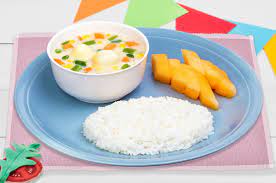
26. Filipino Crab & Corn Soup
Your taste senses will thank you for trying the Creamy Crab & Corn soup.
A pot of chowder made with this flavorful mixture of seafood and corn would be just the thing on a cold day.
This is hard to beat as an appetizer.
It goes great with a delicious sandwich for a snack.
As an added bonus, its subtle flavor will go wonderfully with lunch or dinner.
Ingredients:
1 cup freshly cracked crabmeat
1 medium onion, chopped
2 tablespoons butter
3 cups chicken broth
2 cups whole corn kernel
4 tablespoons All purpose flour
1 cup fresh milk
1/2 teaspoon salt
1/4 teaspoon pepper
2 tablespoons fish sauce sauce
1/8 cup ground parsley
3 tablespoons chopped green onions
Directions
Step 1. In a large saucepan, saute onion in butter until tender.
Step 2. Add flour and stir until blended.
Add milk gradually, stirring constantly.
Step 3. Lower the heat to medium low then add the corn and cook until tender.
Step 4. Add the crabmeat, green onions, parsley, pepper, seasoning salt, and fish sauce and simmer.
Step 5. Cook over low heat until heated through (do not boil).
Step 6. Adjust seasonings to suit your taste.
Step 7. Serve hot with bread.

27. Southern Tagalog Style Goto (Cheek Soup)
This standard recipe is for a rice porridge or congee with ox jowl and skin.
These can be eaten for breakfast or as a substantial mid-morning or late-afternoon snack.
This breakfast fare is typically enjoyed first thing in the morning after prolonged fasting.
An afternoon snack of Goto might restore lost strength and get you back on track.
Those who have been partying or working all night would appreciate this as a late-night snack.
Ingredients
1.5 kilograms (3.3 lbs) of ox jowl and skin and about ¾ kilograms of beef specially added to assure us of a really beefy and tasty soup.
The other ingredients as prepared are: 2 pcs thumb-sized ginger, peeled and sliced, 1 head garlic, peeled and crushed, 4 pcs onions, peeled and chopped, 2 pcs fresh garlic leaves (or leeks), sliced, ¾ cup oyster sauce, 1 tsp freshly ground pepper, salt to taste and lots of beef broth.
Directions
Step 1. Meticulously clean and rinse the meat. Scrape the skin with the knife to remove all dirt and small hair. Arrange the meat in a thick large casserole. Cover with enough water and let it boil under high heat. When the liquid is already boiling and scum is appearing bubbly on the surface, carefully scoop out all the scum that will float until the liquid is clear. This is important to be able to get rid of the foul odor and attain a fragrant and tasty broth.
Step 2. Adjust the heat to the lowest possible while maintaining the liquid still gurgling. Simmer slowly until the meat is just tender. It will take around more than one and half hours, sometimes even longer.
Step 3. Add the ginger, garlic, onion, oyster sauce, salt and ground pepper. Continue simmering on low heat until the meat is very tender. Add beef broth when the liquid level gets lower than the meat level, one cup at a time. Adjust the seasonings including the oyster sauce according to your liking. Cook for several minutes more until the broth is somewhat thick.
Step 4. Serve in wide bowls in batches. Take out some of the meat from the broth. Chopped or cut to small pieces and put into the bowl. Pour enough broth to cover. Sprinkle some chopped garlic leaves or leeks or spring onions on top. Spike with chopped bird?s eye chili as necessary. Serve with slices of ?calamansi? or lemon. While this is a truly comforting dish, it is bound to make you a little restless in the end. 🙂
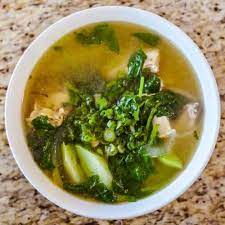
28. Bulanglang Filipino
Vegetables are the basis for the hearty soup or dish known as “bulanglang.”
This is the Batangas variant of Bulanglang, one of several dish variations.
To prepare Bulanglang, simply bring water or rice washing (water used to clean rice) to a boil, add the vegetables and cook them for as long as the package specifies.
You should start by boiling thick and hard veggies like calabaza squash (a winter squash) and green papaya, and then add soft green vegetables like malunggay leaves (moringa).
Ingredients
1 piece small Green Papaya – sliced
2 cups calabaza squash – sliced
1 cup loofah patola, – sliced
2 medium tomatoes – sliced
5 pieces small Okra
1 cup malunggay – moringa leaves
5 cloves garlic – lightly crushed
1 small ginger chopped
1 to 2 teaspoons salt
4 cups rice wash
Directions
Step 1. Heat a cooking pot and pour-in rice washing. Let boil.
Step 2. Add garlic and ginger. Boil for 5 minutes.
Step 3. Add papaya and calabaza squash. Boil for 5 minutes.
Step 4. Add tomatoes, okra, and loofah. Cook for 3 minutes.
Step 5. Add malunggay and salt. Stir. Turn the heat off.
Step 6. Transfer to a serving bowl and serve while hot.

29. Sinabawang Tahong (Gingered Mussel Soup)
Fresh mussels in the Philippines are typically prepared using this method, which is also known as Sinabawang Tahong (Gingered Mussel Soup).
This recipe was influenced by the famous Filipino chicken soup called tinolang manok.
With few ingredients and a light and refreshing ginger-based broth, Sinabawang Tahong may be on the table in no time.
You should try this dish because it is both cheap and tasty.
Ingredients:
— 1 pound fresh tahong (mussels), cleaned
— 1 medium sweet onion, sliced
— 3 cloves garlic, diced
— 1 thumb sized ginger, finely sliced
— 3 fresh tomatoes, chopped into chunks
— 1 tablespoons vegetable oil
— 2-3 tablespoons patis (fish sauce), add more if you want in the end
— 2-3 cups water
— 8oz. Sprite Cola
Directions
Step 1.Thoroughly wash the tahong (mussel) and drain.
Step 2. Place the mussel in a bowl with water and salt.
Step 3. Cover for several hours or overnight. This will allow the clams to expel sand.
Step 4. In a pot, heat oil and saute garlic, onion and ginger.
Step 5. Add tomatoes and saute until soften.
Step 6. Add mussel and stir fry for 2 minutes.
Step 7. Add sprite soda and simmer until shells are opened. Add water if necessary.
Step 8. Add fish sauce and adjust seasoning with salt and pepper.
Step 9. Add water spinach and simmer for 2 minutes.
Step 10. Remove from heat then serve.
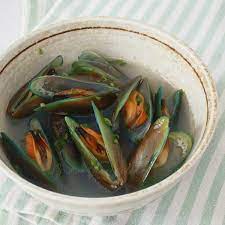
30. Vegan Misua Soup
This vegan soup is a twist on the traditional misua.
It’s topped with chopped spring onions and crispy fried garlic and cooked with tofu, loofah gourd, tomato paste, vegetable broth, vegan fish sauce, and misua.
Loofah gourds, which can be used in this recipe, are ideal when used when young due to their rigid and fibrous texture when fully ripe.
Carrots, baby corn, shiitake mushrooms, and scallions, as well as fried, seasoned tempeh, are all excellent options for toppings.
vegetable oil
tofu
onions
tomato paste
vegetable broth
loofah gourd
oyster mushroom sauce
misua (if you can find the one like in the picture, feel free to use that one instead)
vegan fish sauce
salt and pepper
Step 1. Use a vegetable peeler in peeling the loofah gourd.
Step 2. It is best to use young loofah gourds in this dish because it is tough and fibrous if mature and ripe.
Step 3. Topping options: carrots, baby corn, shiitake mushrooms, and scallions, fried marinated tempeh
Step 4. Protein alternatives: magic meat and fried firm tofu
Step 5. Storage: It is best served immediately as the noodles will absorb a lot of the liquid. If reheating, add additional water or broth to loosen consistency and adjust seasonings.

31. Filipino Matzah Ball Soup
This chicken soup mashup is loaded with authentic Filipino ingredients and spices.
This soup’s base is reminiscent of typical Mexican arroz caldo.
Still, the inclusion of traditional matzah balls and the incorporation of ginger and green onions into the matzah grain make it a distinctive and tasty dish.
Chicken fat is used instead of oil, so there’s no need to brown the chicken as you would for arroz caldo.
Feelings of warmth and comfort, such as those you get from a grandmother’s embrace, can be guaranteed after eating this bowl of pleasure.
Ingredients
For the broth:
4 Tbsp chicken fat (schmaltz)
2-inch piece fresh ginger, peeled and minced
10 cloves garlic, peeled and minced
1 pound of boneless skinless chicken, cut into about 1-inch pieces
64 oz (8 cups) chicken broth
Kosher salt or fish sauce *(most fish sauce is not kosher, this ingredient is optional)
For the matzah balls:
1/2 cup of matzah meal
2-inch piece of fresh ginger, peeled and minced
3 green onions, thinly sliced
2 eggs
2 Tbsp of chicken fat/schmaltz
Kosher salt
For serving (optional):
Lemon or calamansi wedges
Fried garlic
Soft boiled egg
Thinly sliced green onions
Directions
Step 1. To make the broth: In a large Dutch oven pot on medium heat add schmaltz. Add garlic and ginger and cook until fragrant, about 2 minutes. Stir in chicken and cook just until the outer rawness appears cooked, about 2 minutes. Add a generous pinch of salt and pepper.
Step 2. Add chicken broth and cover.
Step 3. Simmer on medium-low heat for about 20-30 minutes. Add fish sauce or salt to taste. (Most fish sauce is not kosher, so you can substitute with extra salt to your liking).
Step 4. To make the matzah balls: In a medium bowl, mix together eggs, schmaltz, green onions, ginger, matzah meal and a generous pinch of kosher salt. Cover and refrigerate for at least 30 minutes.
Step 5. After 30 minutes, use a 1-inch ice cream scoop to scoop dough. Hand roll into balls. Place back in the fridge while you wait for your water to boil.
Step 6. Fill a large pot with water and bring to a boil. Add matzah balls to the pot, leaving some space in between the balls. Lower heat to medium low and cover. Simmer for 30 minutes.
Step 7. To serve: Ladle soup into a bowl and add 1-2 matzah balls. Squeeze a wedge of lemon or calamansi into the soup.
Step 8. Optional step: Thinly slice garlic cloves and fry in oil until golden brown. Top soup with the fried garlic, soft boiled egg, and green onions if desired.

32. Munggo With Pork & Shrimp
Similar to Ginisang Munggo, but with some tweaks, here’s another tasty dish.
Although it takes some time to prepare, the Munggo With Pork & Shrimp meal is well worth it.
A bowl of rice, or even two, would go well with this.
Every bite of the pork and shrimp munggo here satisfies your appetite.
A combination like this will become a staple in your home.
INGREDIENTS
2 lb dried, raw, green, whole mung beans soak according to package
water for pre-soaking mung beans
1 Tbs avocado oil or any cooking oil
3-5 cloves garlic minced
1 medium onion chopped
2 Roma tomatoes cut into wedges
3 Tbs Patis
1 lb pork chopped into bite size pieces
12/16 pieces large shrimp deshelled, tail off, and deveined
1 bunch spinach
1 bunch asparagus chopped 1-1½ inch pieces
salt and pepper to taste
What’s Munggo?
Munggo is a hearty stew or soup filled with so much flavor with every bite. I remember my plate looking like a mountain, with a few spoons of munggo over a couple of scoops of steamed rice. This is one of those dishes that you willingly suffer a burned mouth because you could not wait for it to cool down before eating. The mix of rice, the beans, pork and some spinach in one bite is amazing. Then you rotate the pork with a shrimp every now and then. When we were older, my dad’s recipe changed because he started to add asparagus. This was my introduction to the vegetable and now to this day, it is a staple in my recipe.
If I had a penny for every mung bean…
One of the best pairings that I ever had was munggo and lumpia. Lumpia of course can go with everything but this dinner duo always rang out glorious fatness. But today, we are just going to focus on munggo with pork and shrimp. I won’t lie, this is not a dish to whip up before dinner because you didn’t have anything planned. More than likely, you are going to buy a package of raw, dry mung beans.
I like to soak them in water to soften them up before cooking. Over night or throughout the day is fine. Soaking them is not necessary but it speeds up the cooking time and, in my mind, softening them up before cooking makes them more receptive to the numerous flavors of the other ingredients.
Ingredients:
2 lb bag of Mung Beans
Water
Avocado Oil: Similar nutritional qualities of Olive Oil but Avocado Oil can be used for high temp sautéing
3-5 (pending on your love of garlic) Cloves of Garlic: minced or sliced is fine but I like to use a wooden mortar and pestle to grind up the garlic to spread it and its oils throughout the dish
1 Onion chopped: I do ¼ – ½ inch pieces. If the kids don’t see it, then they’ll eat it.
2 Tomatoes: wedged
3 tbs Patis (fish sauce): Don’t leave this out!!! Salt is not an ingredient in this recipe but if you want to include it, just add to taste.
1 lb of Pork: Cut into bite sized pieces
Pepper
12/16 count Large Shrimp: Unshelled, tail off and deveined
1 bunch of Spinach
1 bunch of Asparagus (1 to 1½ inch cuts)
Mung Bean Prep
Thoroughly rinse and wash the mung beans. This can be done with a colander, but you may find out that the wholes are bigger than the beans. Mesh strainers work well to wash away small, loose particles but you are going to want to find the bad ones of the bunch, if there are any. I like washing them in the sauce pan that they will be cooked in, just like washing rice. This gives me the opportunity to find anything that needs to be discarded.
After washing, fill up the pan with enough water to fully immerse the mung beans. I level off the beans stick my fingers straight into them and look at how deep it is with my middle finger. I then fill up the pan with water to the same line with my middle finger at the top of the beans. Again, I do this process at leisure the day before or earlier in the day if I’m cooking for dinner.
Preparing the mung beans will take some time. Prepare them in advance.
Raw Mung Beans
At this point you can do whatever you want to do. This is a good reminder that cooking should be a relaxing and satisfying. Stressful cooking experiences come from time constraints or trying to “bite off more than you can chew” when choosing a dish to cook. At the same time, every now and then, you should experiment with new or difficult dishes. It is the best way to learn and improve your craft.
Time to Cook Dinner
Before the family gets hungry, get back into the kitchen. The first step is to cook the mung beans. You’ll see that the contents in the pan have increased. No, no one is playing a trick on you, the beans have expanded because they are absorbing the water. Be sure to add more water before you start to boil them. You may also notice that some of the bean have started to sprout. Not to worry but it is a pretty cool gardening or science experiment.
Like rice, boil and watch. If the water gets close to flowing over the top of the pan then reduce your heat. A slow and steady boil is what you want. If you lose water, it is okay to add more. This process can take up to 30 minutes, depending on how long or if you soaked the beans at all. You will know when they are ready when they are considerably softer.
Historically, some Asian cultures used kneeling on Mung beans as a form of punishment. If you had to prepare the beans for your punishment, you’ll know the difference between soft and hard. Either smash one with a spoon or throw one in your mouth. Don’t cook until you can make refried mung beans, just soft enough to be inadvertently smashed while mixing with the rest of the ingredients.
The final dish will cook for a bit when all ingredients are combined, so there will be time for some of the beans to get mashed and thicken the soup. I love a mixture of full beans and mashed, with each bite.
Pan to Pot
Munggo with Pork and Shrimp. Masarap!
Pork and Shrimp
Second, which can be done while the beans are cooking, gather and prep all of the ingredients for the ginisang, or the sauté stage. You will need the oil, garlic, onions and tomatoes. It is better to use a stock pot when cooking this dish, rather than your biggest sauce pan. You’ll soon see why. The stock pot that I used just fits the ingredients of this recipe. You’re going to want to use something bigger. I used this pot for picture purposes.
Warm up the pot at a medium/high heat. Drop a piece of onion in the oil, if it sizzles, the oil is ready. Add in and stir the rest of the onions, followed by the tomato wedges. Continue until onions are soft and the wedges are pureed. The tomatoes will add to the overall flavor. Next you can add in the garlic. I like adding the garlic last to preserve its texture and oils.
Time For the Pork
Immediately stir in the pork. I like to cook the garlic and pork together so that the garlic flavor infuses into the pork. With this in mind, this is when I add the Patis and fresh grounded pepper. Stir the contents well, with flavor in mind. Lower the heat to medium when pork is just about cooked.
Down to Just the Pot
Add the pan of the cooked mung beans along with the water. If the water is murky, it’s not dirty. It is the start of the mashing process of some of the beans. Again, it will thicken the soup. Add more water in increments of 1 cup, to prevent from making it too watery and losing flavor. You are looking for somewhere a little soupier than a beef stew or comparable. Definitely not French onion soup. The more you cook or eat this dish, the better you will know its consistency.
The Finishing Touches
I should name it Munggo with Spinach, Pork and Shrimp
Fresh Spinach
Continue to cook on a medium heat and stir to continue to infuse all of the flavors. Now it’s time to add the asparagus cuts and shrimp. Be sure to rinse the shrimp off before adding, to get rid of stray shells or broken tail pieces. Don’t be concerned about the cook time for the shrimp and asparagus. They will cook sufficiently before serving time. Stir contents well .
Last but not least, rinse your spinach well. If you bought spinach by the bunch, there still might be some dirt, mud or insects mixed in. This is not a spinach salad, so the stems of the spinach do not need to be removed. We love lots of spinach in our munggo. This is where the bigger stock pot comes handy. Slowly stir in the spinach and let it simmer until dinner time. Continue to stir your Munggo with pork and shrimp occasionally.
Give it a taste test. At this point it should be on the less salty side. This is the health-conscious side of my cooking. You can add more Patis if you want to increase its saltiness. Add to taste, don’t go fire hose with the bottle.
Enjoy you Munggo with Pork and Shrimp.
Enjoy!
As the pot sits, waiting for serving, if the beans are not quite ready, they will continue to absorb water, while others will break apart to add to the thickness of the soup. Add water before serving if necessary and stir well.
I hope that you didn’t forget to press the cook button on your rice cooker.
Enjoy and feel free to send us pictures of your Munggo with Pork and Shrimp dish!
Munggo with Pork and Shrimp
Cooking Munggo with Pork and Shrimp is a lengthy process but the final dish is worth the time. Served over rice and you have the perfect Fall dish.
Print Recipe
Pin Recipe
PREP TIME
1 d
COOK TIME
45 mins
COURSE
Main Course
CUISINE
Filipino
SERVINGS
10 people
INGREDIENTS
2 lb dried, raw, green, whole mung beans soak according to package
water for pre-soaking mung beans
1 Tbs avocado oil or any cooking oil
3-5 cloves garlic minced
1 medium onion chopped
2 Roma tomatoes cut into wedges
3 Tbs Patis
1 lb pork chopped into bite size pieces
12/16 pieces large shrimp deshelled, tail off, and deveined
1 bunch spinach
1 bunch asparagus chopped 1-1½ inch pieces
salt and pepper to taste
Directions
Step 1. Wash mung beans, discard and bad ones you may find.
Step 2. Fully immerse mung beans and allow to soak according to package directions. *we soak for a whole day.
Step 3. Boil Mung Beans for 30 mins and add water accordingly.
Step 4. Saute onions and tomatoes with oil at medium/high heat.
Step 5. Add Garlic and Pork and stir.
Step 6. Lower heat to medium and add Patis and pepper.
Step 7. Add all the pot ingredients (mung beans and water) to the pan (saute ingredients). Stir occasionally.
*Note: the pork does not have to be fully cooked at this step.
Step 8. Continue to simmer on a medium heat and stir. Add water 1 cup at time as needed.
Step 9. Add asparagus and shrimp. Stir.
Step 10. Add spinach. Stir
Step 11. Simmer until asparagus is soft.
Step 12. Add salt, pepper or Patis, to taste.
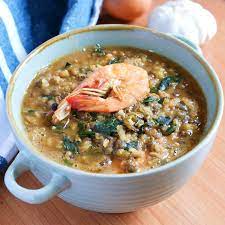
33. Crab & Shrimp In Patola & Misua
Incorporating crab flesh into the soup with the misua noodles (wheat vermicelli) results in a rich and velvety texture.
Simple to prepare, this dish will have you working up a sweat as you eat it.
To make this dish, you’ll need crab, shrimp, misua, and a young loofah (or patola).
Together, this dish’s crab, shrimp, and green chilis produce a flavor that’s hard to resist.
INGREDIENTS:
Crab
Shrimp
Patola
Ginger
Garlic
Onion
Misua noodles
Green chili
Salt
Cooking oil
Water
DIRECTIONS:
Step 1. Boil the crab and shrimp.
Step 2. Saute the crab and shrimp in ginger, garlic, and onion.
Step 3. Simmer for a minute then add water, salt, green chili, patola, and misua noodles.
Step 4. Mix. Bring to boil, simmer for few minutes then serve.
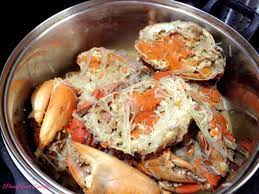
34. Receta Boiled Mudfish Soup With Veggies (Pesang Dalag)
In this dish for Pesang Dalag, mudfish, potatoes, and vegetables are simmered in a ginger-flavored broth and served in a scrumptious soup.
Filipinos use the pesa cooking style, a method of preparing fish or poultry in a broth flavored with ginger.
This boiled soup is commonly served with rice and miso sauce.
This dish is perfect for any season because it is both light and refreshing, as well as robust and comforting.
Ingredients
whole mudfish, gutted, scaled, cleaned and cut into serving parts
2 medium potatoes, peeled and quartered
2 to 3 stalks green onions, cut into 4-inch lengths
1 bunch bokchoy, ends trimmed and leaves separated
1 small napa cabbage, ends trimmed and leaves separated
1 small onion, peeled and sliced
2 to 3 cloves garlic, peeled and minced
1 knob-size ginger, peeled and julienned
canola oil
5 to 6 cups water or rice washing
1 tablespoon fish sauce
salt and pepper to taste
Directions
Step 1. Season fish with salt and pepper to taste. In a skillet, heat about 1-inch of oil on medium heat. Fry fish, turning once or twice, until lightly brown. Remove from pan and drain on paper towels.
Step 2. In another pan, heat about 1-inch of oil over medium heat. Deep-fry potatoes until lightly brown and tender. Remove from heat and drain on paper towels.
Step 3. In a pot, heat about 1 tablespoon of oil. Add onions, garlic and ginger and cook for about 2 to 3 minutes or until fragrant. Add fish sauce and continue to cook, stirring occasionally, for about 1 to 2 minutes.
Step 4. Add water and bring to a boil. Add fish and potatoes and cook for about 5 to 7 minutes or until fish and potatoes are fully cooked through. Add pechay and cabbage and continue to cook for about 2 to 3 minutes or until vegetables are tender yet crisp. Add green onions and continue for about another 30 seconds. Season with salt and pepper to taste.
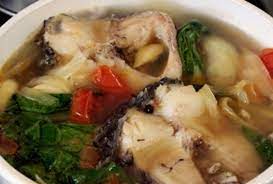
35. Filipino Cioppino (Seafood Coconut Milk Stew)
This dish cooks tender pieces of fish and fresh seafood in rich coconut broth.
Based on a legendary Filipino eatery in San Francisco, this Asian take on Cioppino is a must-try.
It’s not too complicated, as there are only four major classes of ingredients: seafood, mirepoix, aromatics, and liquid spices.
If you want to save time, a bag of frozen mixed seafood can be thrown into the pot all at once, and the seafood can be simmered until it is hot.
Vouvray (or French Chenin blanc) is an excellent choice of wine to pair with this dish, whether you go for the still or sparkling variety.
Ingredients
▢2 1/2 lb mixed seafood clams, mussels, white fish, shrimp, scallops, squid
Coconut milk stock
▢1 can coconut milk or 2 cups
▢1/2 c white wine
▢1 ea jalapeno deseeded if you prefer less spice
▢1 Tb fish sauce
▢1/2 ea carrot small dice
▢1 stalk celery small dice
▢1/2 ea onion small dice
▢2 cloves garlic minced
▢2 tsp ginger minced
▢1 ea green onion finely chopped
Directions
Step 1. Combine all coconut milk stew ingredients in a large saucepan. Bring to a simmer, and cook for 15-20 minutes.
Step 2. Make sure all the seafood is cleaned and ready to cook. Fish should be skinned, deboned, and cut into 2″ chunks. Shrimp should be peeled and deveined. Scallops should have the sinewy adductor mussel torn off. Mussels should be scrubbed and debearded. Clams should be soaked in a little salt water to remove any sandy grit. Squid should be cut into 2″ chunks.
Step 3. Gently add fish chunks to simmering stock. It should only take a few minutes to cook until opaque and firm to the touch. Remove from pot and set aside.
Step 4. Add scallops and shrimp if using. Cook in simmering stock for a few minutes until cooked and remove. Remove and set aside.
Step 5. Add clams and mussels to the stock. Cook until opened. Discard any mussels that have not opened. Unopened clams can be cooked longer until opened. Add scallops and shrimp back into the broth to reheat.
Step 6. Spoon fish into bowls. Ladle over the coconut seafood stew into bowls. Serve hot, and with brown rice.
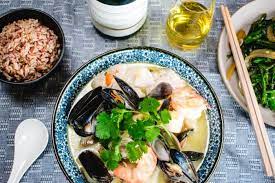
Conclusion
In the Philippines, soup is always an option.
From our list, you can see that Filipino soups are inexpensive to make, can feed a large group, and uses few ingredients.
These delicious Filipino soups aren’t just filling; they may also lift your mood and chase away fatigue.
So if you’re looking to spice things up at dinner, try out one of these recipes; your guests won’t be able to resist the aroma of the soups alone!
And oh, before I forget, aside from soup recipes no one could ever resist, Filipino cuisines are also rich in a lot of other delightful recipes.
Frequently asked questions
What is the most famous soup in the Philippines?
Tinola (Philippines)
In this broth, chicken and local vegetables are cooked, such as papaya and chayote. There are other varieties of this soup with fish, seafood and various proteins. The best known is Tinolang Manok, which means Chicken Soup.
What is the best soup in the world Filipino?
Sinigang
According to the Taste Atlas Awards, the international food database, the Filipino favorite, Sinigang, is hailed as the best soup in the world.
What is the most popular Filipino food?
Adobo
Adobo. The most popular Filipino food and referred to as the unofficial national dish of the Philippines, Adobo is commonly chicken (though pork is a 2nd favourite option) simmered in vinegar, garlic, black peppercorns, soy sauce, and bay leaves.
What is the No 1 soup in the world?
Especially as Northern Thai cuisine is sometimes overlooked, it’s nice to see a dish like khao soi get the spotlight
What are the 4 main soups?
There are four main categories of soup: Thin, Thick, Cold and National. These types of soup are widely recognised in today’s modern kitchen.
